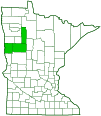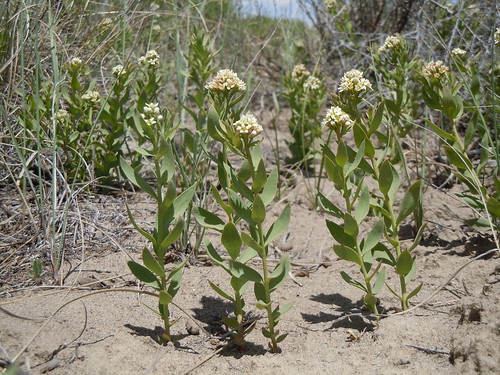pale bastard toadflax
(Comandra umbellata ssp. pallida)
Conservation • Wetland • Description • Habitat • Ecology • Use • Distribution • Taxonomy
Conservation Status |
|
|||||||
| IUCN Red List | not listed |
|||||||
| NatureServe | N5 - Secure SNR - Unranked |
|||||||
| Minnesota | not listed |
|||||||
Wetland Indicator Status |
||||||||
| Great Plains | UPL - Obligate upland |
|||||||
| Midwest | FACU - Facultative upland |
|||||||
| Northcentral & Northeast | FACU - Facultative upland |
|||||||
Description |
||
Pale bastard toadflax is a 4″ to 12″ tall, erect, often branched, leafy, perennial herb that rises from fibrous roots and horizontal rhizomes. It often forms colonies and a single clone can cover a large area. It is semi-parasitic, deriving water and nutrition from the roots of other plants, but also getting nutrition from photosynthesis. Hosts for this parasite includes herbs such as Aster, Antennaria, Solidago, shrub species such as Rosa, Rubus, Fragaria, Vaccinium, tree species such as Acer, Betula, Populus, as well as Carex and various grasses. The stems are light green, hairless, leafy, and usually branched. The leaves are alternate or scattered, hairless, untoothed. They are green on both sides, covered with a whitish, waxy coating on the upper surface, and lack evident lateral veins. They are oval, more than half as wide as long, or oblong, two to four times longer than wide with nearly parallel sides. They are ¾″ to 2″ long and up to ¾″ wide. They attach to the stem with a short leaf stalk or no leaf stalk at all. The tips are usually pointed. The inflorescence is a compact, somewhat flattened cluster of 12 or more small flowers at the end of some of the stems. The flowers are ¼″ wide and funnel-shaped. There are 3 to 6 (usually 5) petal-like, greenish-white to white tepals (sepals), fused at the base into a floral tube (hypanthium), and flared at the tips. The tepal lobes beyond the floral tube are ⅛″ long or longer. There are no petals. The flowers are not fragrant. The fruit is small, ¼″ to ⅓″ thick, nearly spherical, fleshy, edible, and contains a single seed. They are at first green, then turn brown as they mature. |
||
Height |
||
4″ to 12″ |
||
Flower Color |
||
Greenish-white to white |
||
Similar Species |
||
Bastard toadflax (Comandra umbellata ssp.umbellata) is a more eastern variety and is found throughout the western portion of the state. The leaves are thinner and often wider. They are not glaucous. They have net-like, lateral veins that are evident on both surfaces. The tepal lobes beyond the floral tube are wider and less than ⅛″ long. It has smaller fruit, ⅛″ to ¼″ thick. False toadflax (Geocaulon lividum) is a northern species. It has been recorded only in Cook and Roseau Counties. It has greenish-purple flowers rising from the middle and upper leaf axils. The flowers do not have a hypanthium. The fruit is an orange to red, juicy berry. |
||
Habitat |
||
Dry, moderate, or wet. Prairies, prairie fens, open woods, shores, dunes. Full or partial sun. |
||
Ecology |
||
Flowering |
||
May to July |
||
Pests and Diseases |
||
|
||
Use |
||
|
||
Distribution |
||||
|
Sources |
|||
| 2/18/2023 | ||||
Nativity |
||||
Native |
||||
Occurrence |
||||
Uncommon in Minnesota |
||||
Taxonomy |
|||
| Kingdom | Plantae (Plants) | ||
| Division | Tracheophyta (Vascular Plants) | ||
| Subdivision | Spermatophytina (Seed Plants) | ||
| Class | Magnoliopsida (Dicots) | ||
Order |
Santalales (snadalwoods, mistletoes, and allies) | ||
Family |
Santalaceae (sandalwood) | ||
Genus |
Comandra (comandras) | ||
| Species | Comandra umbellata (bastard toadflax) | ||
Genus Family |
|||
Synonyms |
|||
Comandra pallida Comandra umbellata var. angustifolia Comandra umbellata var. pallida |
|||
Common Names |
|||
bastard toadflax bastard-toadflax common toadflax pale bastard toadflax Pine bastard toadflax western comandra |
|||
Glossary
Axil
The upper angle where the leaf stalk meets the stem.
Glaucous
Pale green or bluish gray due to a whitish, powdery or waxy film, as on a plum or a grape.
Hypanthium
A cup-like tubular structure of a flower formed from the fused bases of sepals, petals, and stamens, that surrounds the pistil. Its presence is diagnostic of many families, including Rose, Gooseberry, and Pea.
Sepal
An outer floral leaf, usually green but sometimes colored, at the base of a flower.
Tepal
Refers to both the petals and the sepals of a flower when they are similar in appearance and difficult to tell apart. Tepals are common in lilies and tulips.
Visitor Photos |
|||||
Share your photo of this plant. |
|||||
| This button not working for you? Simply email us at info@MinnesotaSeasons.com. Attach one or more photos and, if you like, a caption. |
|||||
|
|||||
MinnesotaSeasons.com Photos |
|||||
|
|||||


Visitor Videos |
|||
Share your video of this plant. |
|||
| This button not working for you? Simply email us at info@MinnesotaSeasons.com. Attach a video, a YouTube link, or a cloud storage link. |
|||
Other Videos |
|||

Visitor Sightings |
|||||
Report a sighting of this plant. |
|||||
| This button not working for you? Simply email us at info@MinnesotaSeasons.com. Be sure to include a location. |
|||||
|
|||||
MinnesotaSeasons.com Sightings |
|||||
|
|||||

|
Created: Last Updated: © MinnesotaSeasons.com. All rights reserved. |

